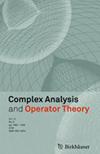多个四元变量的片正则函数的阿尔曼西式分解
IF 0.7
4区 数学
Q2 MATHEMATICS
引用次数: 0
摘要
在本文中,我们为多个四元变量的切片正则函数提出了一种阿尔曼斯式分解法。我们的方法可以为任何域在\(\mathbb {H}^n\)中的切片函数得到\(2^n\)个不同且唯一的分解。根据分解的选择,每个分量都是明确给出的、唯一确定的,并表现出理想的特性,如所选变量的谐波性和循环性。作为这些分解的结果,我们给出了 Fueter 定理在 \(\mathbb {H}^n\) 中的另一个证明,建立了片正则函数在每个变量中的双调和性,并推导出了它们的均值和泊松公式。本文章由计算机程序翻译,如有差异,请以英文原文为准。
Almansi-Type Decomposition for Slice Regular Functions of Several Quaternionic Variables
In this paper we propose an Almansi-type decomposition for slice regular functions of several quaternionic variables. Our method yields \(2^n\) distinct and unique decompositions for any slice function with domain in \(\mathbb {H}^n\). Depending on the choice of the decomposition, every component is given explicitly, uniquely determined and exhibits desirable properties, such as harmonicity and circularity in the selected variables. As consequences of these decompositions, we give another proof of Fueter’s Theorem in \(\mathbb {H}^n\), establish the biharmonicity of slice regular functions in every variable and derive mean value and Poisson formulas for them.
求助全文
通过发布文献求助,成功后即可免费获取论文全文。
去求助
来源期刊
CiteScore
1.20
自引率
12.50%
发文量
107
审稿时长
3 months
期刊介绍:
Complex Analysis and Operator Theory (CAOT) is devoted to the publication of current research developments in the closely related fields of complex analysis and operator theory as well as in applications to system theory, harmonic analysis, probability, statistics, learning theory, mathematical physics and other related fields. Articles using the theory of reproducing kernel spaces are in particular welcomed.

 求助内容:
求助内容: 应助结果提醒方式:
应助结果提醒方式:


